teaching
Gamification in the classroom: beyond Kahoot!
Comparison of paid and free apps for playful activities in the classroom.
I recently tested the app CrowdParty , which aims to be a gamification alternative to Kahoot! , a true edtech giant. CrowdParty's proposal is to help break the ice between participants in virtual and face-to-face meetings, through electronic games that invite socializing (in the world of work) and learning (in the academic environment).
These characteristics define the market for tools for interacting with the public. This assumes that you already have a presentation in progress, as tools like CrowdParty are just an accessory to communication . It is very important to highlight this feature, as it follows that the remote user will need two screens or even two devices to interact, one to follow the meeting and the other to play properly.
The classic games of this type of tool are trivia and riddles. But CrowdParty already has some variations of these games, whose content can be customized. In fact, despite having some advanced settings, The platform is still in the early stages of development , not having some basic tools, such as interface translation. That's why any direct comparison with Kahoot! it would be unfair.
In terms of price, CrowdParty is free for up to 10 players, which is compatible with other free plans on the market. Plans for 50 players start at USD 20/month, which I consider a high value:

CrowdParty is not the only alternative to Kahoot!, and there are several apps on the market that intend to exploit opportunities left by the segment leader. Or AhaSlides , for example, has a free plan with different types of questions, in addition to offering a slide tool focused on teachers. The price is competitive, costing USD 5/month for up to 50 players.
If you need a free solution for up to 25 people, the Poll Everywhere seems to be the only option. It is an option with a more sober look than the others. The GimKit , despite being a small company, focuses on corporate plans for schools, starting at USD 1,000/year/school. Still within the educational market, with the difference of being more oriented to the activity of applying tests and being more sober, there is the ClassMaker .
There is also the Quizizz , which is perhaps the most direct competitor to Kahoot!, given its huge library of templates. Despite this large collection, the types of questions available are limited. Its price is USD 19/month for the 100-player plan. Or Slido , in turn, is an option focused on the corporate market , much more than in education. It has the great advantage of a free plan with up to 100 players, but limited to three polls:
In conclusion, there are several alternatives when it comes to engaging your audience in person or virtually. Some are more corporate solutions and others are more educational, although generally the apps cater to both.
If you're looking for a free plan, the choice will depend on the size of your audience . Although it has limitations, Slido is the only one that allows up to 100 participants. Next, Poll Everywhere is also the only one to allow 25 participants in the free plan. The other apps offer free plans only for small groups, which for me would be insufficient.
Before convincing you to use the XMind , you need to be convinced to use a mind mapping tool. But what is a mind map?
It is a visual representation of your ideas, usually structured in a tree format.
If you need visual support to learn and memorize or if you need to present any content visually to others, mind maps are for you. If you prefer lists or cards to study and take notes on, you may be more productive to take another approach. A traditional mind map looks something like this:
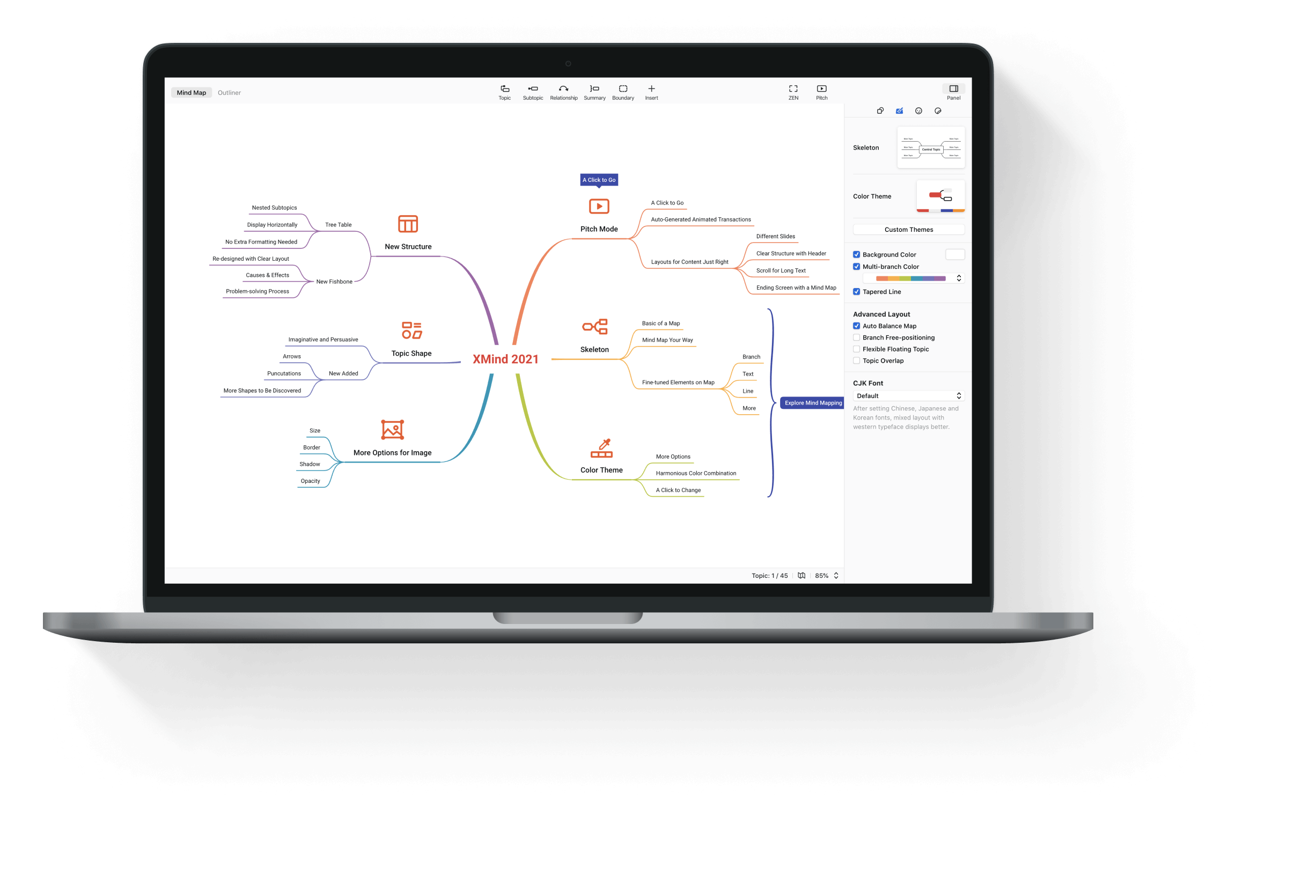
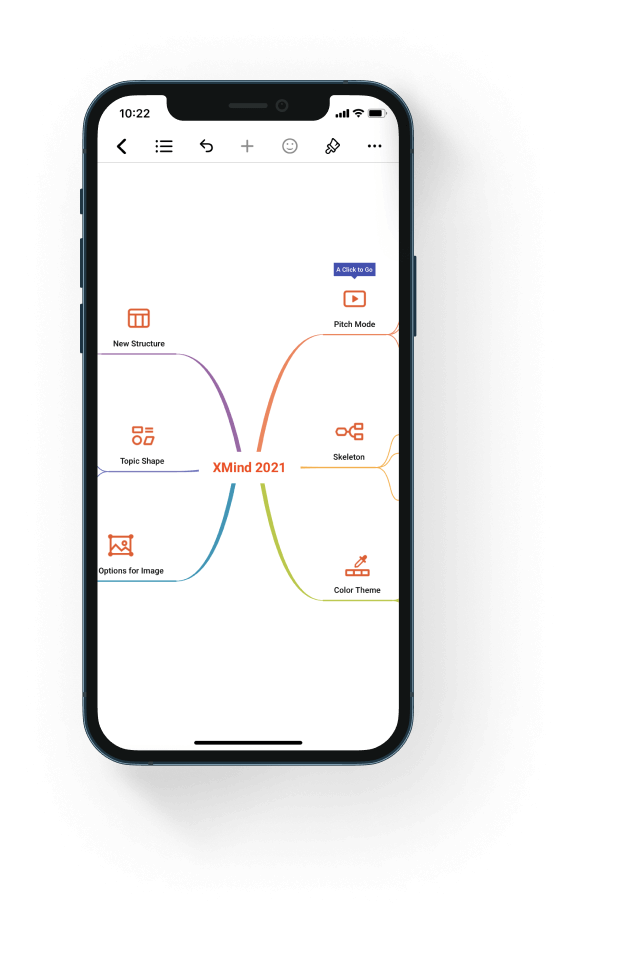
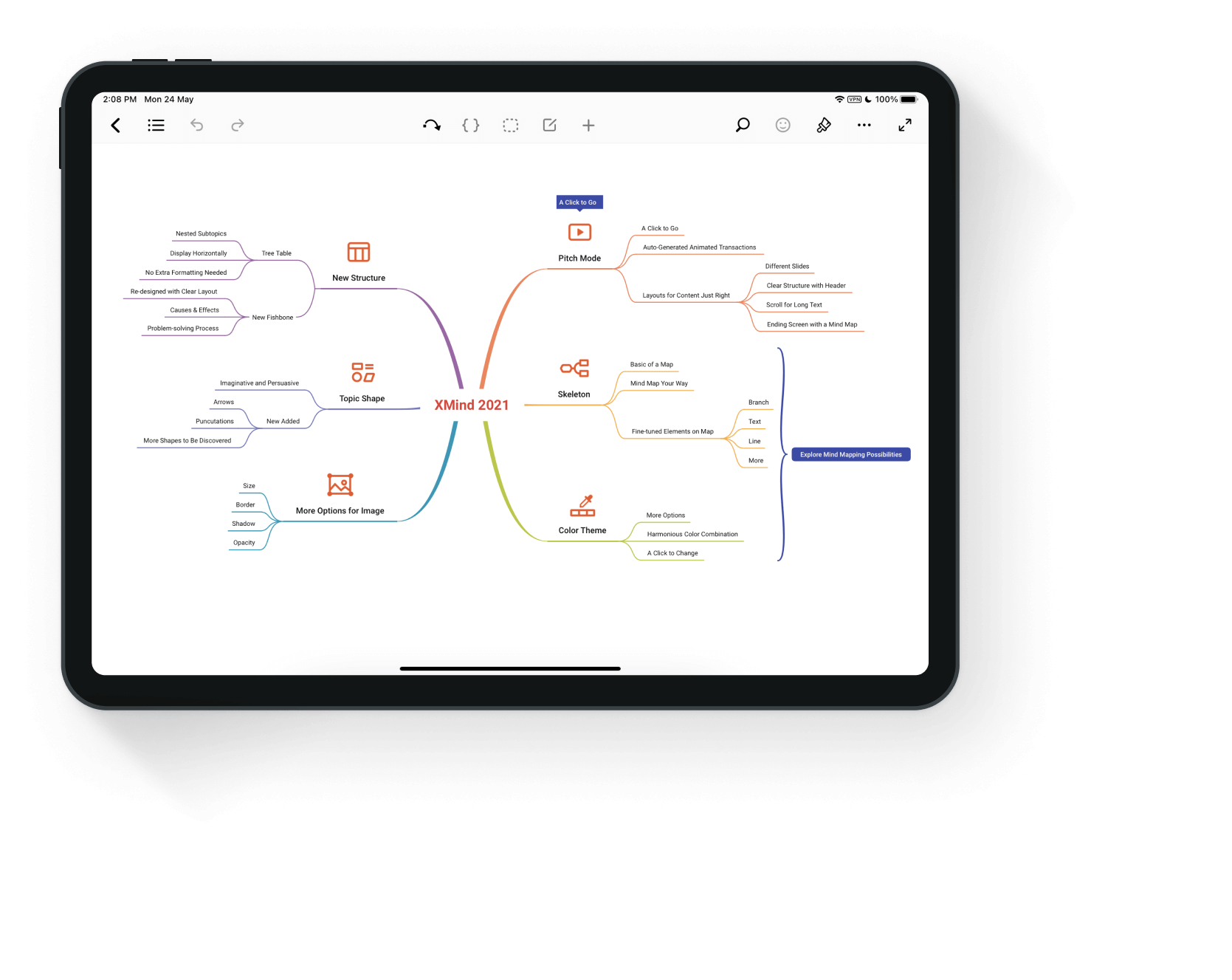
I'm a fan of mind maps, because I think they really work . Throughout all the years that I have used mind maps to teach or to present concepts to clients, it has almost always worked. As for the few times when mind maps didn't work, I imagine it was the wrong tool for the audience. If the audience is made up of people who are very focused on orality, I avoid visual presentations with animated transitions.
Today, however, this is the exception. Most people accept and feel cared for by explanations accompanied by diagrams. On the other hand, just the diagram without any explanation will certainly not work. This is one of the reasons why mind maps only work well when made by you . The same problem occurs if you try to read someone else's notes, because mind maps are still spatially arranged notes.
While it is possible to draw a mind map with pen and paper, apps have made this process enormously easier. This is because you don't need to know how to draw, you just need to indicate if the next step is a puppy (using the tab for this) or a sibling (using enter for this) of the last edited item. It is also possible to use the mouse to do this, but with the keyboard it is much more practical.
Bigglerplate is a site that maintains a List of mind map apps and he points to XMind as one of the most popular solutions. You can compare all the alternatives there, but here I will give my reasons why XMind is a very competitive solution:
- Your trial does not expire. The only difference to the paid version is some features that you may not need, for example, exporting in high definition and converting the mind map into a presentation.
- The desktop version works fine on Windows or Mac. So you don't need to be online to make your mind maps.
- Even within the same conceptual tree structure, there are several ways of displaying content. This is a unique feature of XMind and the reason why I can't use any other competing app.
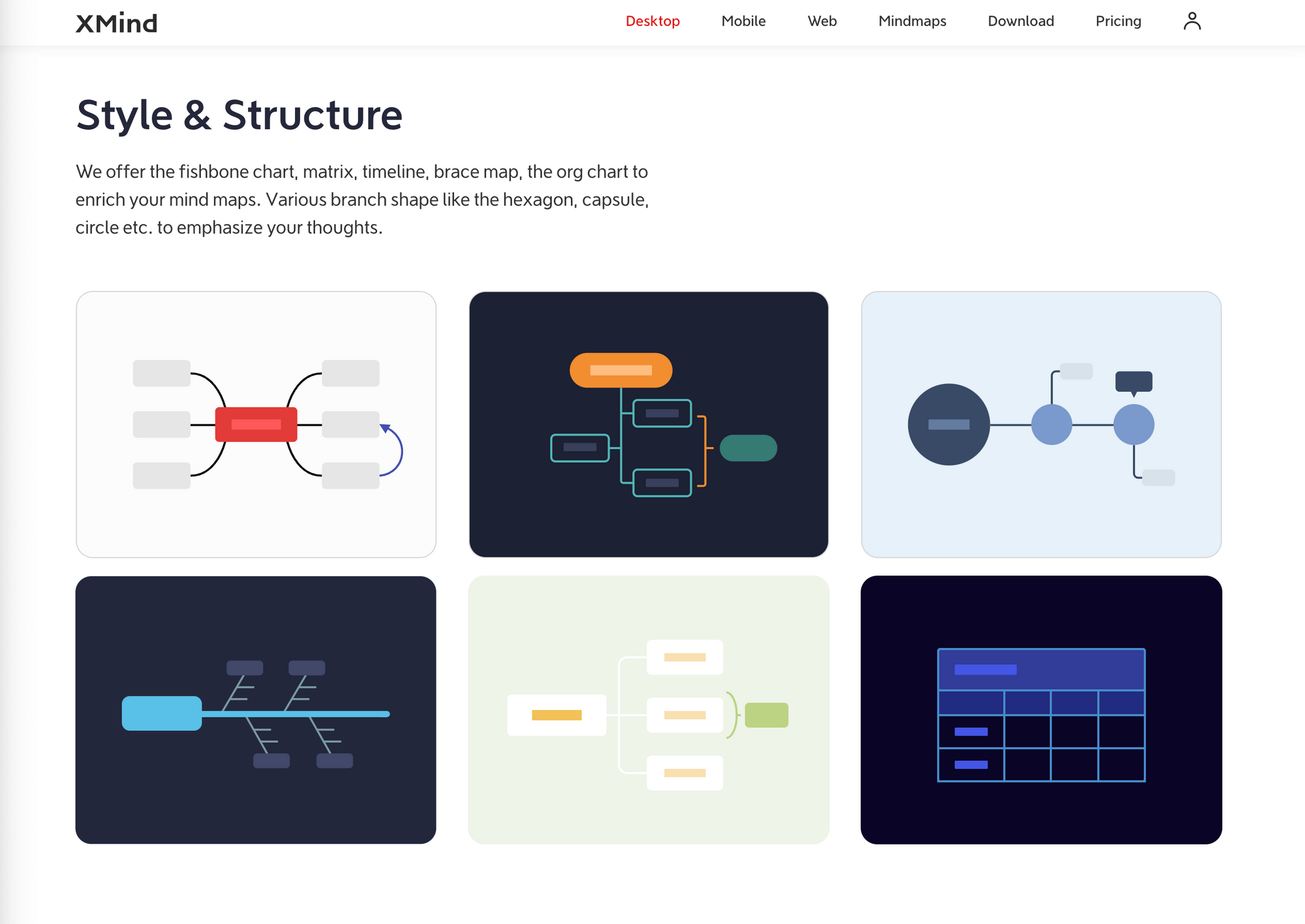
- If structures are XMind's differential, it is also important that it has all the basic tools of the competition: links, sets, keys, notes, labels and balloons. This exists (or needs to exist) in every good mind map app.

- XMind has annual updates and has been constantly evolving. However, the last edition brought news that don't interest me so much: a new visualization and new ways of presentation.
For all these reasons, XMind is an irreplaceable app for me.
In case you don't confirm my opinion, there are several options recommended by Biggerplate: MindMeister (emphasis on online collaboration, but only three free maps); MindNote (very beautiful, but only for Mac); and, finally, MindManager or MindGenius (corporate options focused on project management at the price of more than USD 160 per year).
In addition to these, there are: Miro (good whiteboard tool that also has mind maps, but limited to three editable boards); Coggle (very beautiful and perhaps the best to share, as long as the mind maps are public); and Scapple (a kind of whiteboard aimed at Scrivener users).
From this comparison, it is clear that Exist Mind Map Apps That Want to Enter the Project Management Market . Usually they are very expensive and do not interest me. There are also diagram editing apps that occasionally serve to edit mind maps . I prefer the other way around: a mind map app that occasionally serves to elaborate a diagram.
In addition, there are Web apps with a focus on collaboration , which is not my interest. What I'm looking for is a simple way to organize my ideas before sharing what I think. If your need is similar to mine, XMind may be the best option. But the list of all the alternatives is very long and any omission here does not mean that the app is bad.
In fact, the complete list would be practically inexhaustible, especially if we consider that today mind map applications have started to compete in the segment of productivity and real-time collaboration.
I hope these guidelines help you position the apps you decide to try and their closest alternatives , because the search can really become long and confusing. Just look at the infinity of posts on the internet that intend to list all the available programs, without much contributing to your decision.
Good choice!
Before convincing you to use the XMind , you need to be convinced to use a mind mapping tool. But what is a mind map?
It is a visual representation of your ideas, usually structured in a tree format.
If you need visual support to learn and memorize or if you need to present any content visually to others, mind maps are for you. If you prefer lists or cards to study and take notes on, you may be more productive to take another approach. A traditional mind map looks something like this:



I'm a fan of mind maps, because I think they really work . Throughout all the years that I have used mind maps to teach or to present concepts to clients, it has almost always worked. As for the few times when mind maps didn't work, I imagine it was the wrong tool for the audience. If the audience is made up of people who are very focused on orality, I avoid visual presentations with animated transitions.
Today, however, this is the exception. Most people accept and feel cared for by explanations accompanied by diagrams. On the other hand, just the diagram without any explanation will certainly not work. This is one of the reasons why mind maps only work well when made by you . The same problem occurs if you try to read someone else's notes, because mind maps are still spatially arranged notes.
While it is possible to draw a mind map with pen and paper, apps have made this process enormously easier. This is because you don't need to know how to draw, you just need to indicate if the next step is a puppy (using the tab for this) or a sibling (using enter for this) of the last edited item. It is also possible to use the mouse to do this, but with the keyboard it is much more practical.
Bigglerplate is a site that maintains a List of mind map apps and he points to XMind as one of the most popular solutions. You can compare all the alternatives there, but here I will give my reasons why XMind is a very competitive solution:
- Your trial does not expire. The only difference to the paid version is some features that you may not need, for example, exporting in high definition and converting the mind map into a presentation.
- The desktop version works fine on Windows or Mac. So you don't need to be online to make your mind maps.
- Even within the same conceptual tree structure, there are several ways of displaying content. This is a unique feature of XMind and the reason why I can't use any other competing app.

- If structures are XMind's differential, it is also important that it has all the basic tools of the competition: links, sets, keys, notes, labels and balloons. This exists (or needs to exist) in every good mind map app.

- XMind has annual updates and has been constantly evolving. However, the last edition brought news that don't interest me so much: a new visualization and new ways of presentation.
For all these reasons, XMind is an irreplaceable app for me.
In case you don't confirm my opinion, there are several options recommended by Biggerplate: MindMeister (emphasis on online collaboration, but only three free maps); MindNote (very beautiful, but only for Mac); and, finally, MindManager or MindGenius (corporate options focused on project management at the price of more than USD 160 per year).
In addition to these, there are: Miro (good whiteboard tool that also has mind maps, but limited to three editable boards); Coggle (very beautiful and perhaps the best to share, as long as the mind maps are public); and Scapple (a kind of whiteboard aimed at Scrivener users).
From this comparison, it is clear that Exist Mind Map Apps That Want to Enter the Project Management Market . Usually they are very expensive and do not interest me. There are also diagram editing apps that occasionally serve to edit mind maps . I prefer the other way around: a mind map app that occasionally serves to elaborate a diagram.
In addition, there are Web apps with a focus on collaboration , which is not my interest. What I'm looking for is a simple way to organize my ideas before sharing what I think. If your need is similar to mine, XMind may be the best option. But the list of all the alternatives is very long and any omission here does not mean that the app is bad.
In fact, the complete list would be practically inexhaustible, especially if we consider that today mind map applications have started to compete in the segment of productivity and real-time collaboration.
I hope these guidelines help you position the apps you decide to try and their closest alternatives , because the search can really become long and confusing. Just look at the infinity of posts on the internet that intend to list all the available programs, without much contributing to your decision.
Good choice!
In search of a bulletin board for the blog
Comparison between the main community management and chat applications aimed at the corporate market. The mission is to avoid Whatsapp at all costs.
To improve communication with my students, I always looked for a simple tool. The main goal was to avoid the ubiquitous Whatsapp , as I understand it is important to separate personal and professional communication. Incredible as it may seem, this can currently be considered an ambitious goal.
In addition, he was looking for a form of communication in the style of an open forum, not of private contact with each of the students. What I wanted to do with this was to have a very simple bulletin board, so that I could record where I stopped and what the schedule of the next class would be.
That is, I wanted to create a digital class journal.
I also wanted to make it possible for the public to be accessible, because I know that the need for authentication for reading ends up being a huge barrier. As I already had a blog, I was looking for a more agile communication than a normal post, more along the lines of a chat. Finally, I wanted it to be a free solution.
My option ended up being the Gitter , which is a fairly simple community management platform. While Gitter doesn't define its audience as programmers, it's pretty clear that it's about community management for these professionals. Either way, there's nothing stopping us from taking advantage of the wonderful tools that developers create for you.
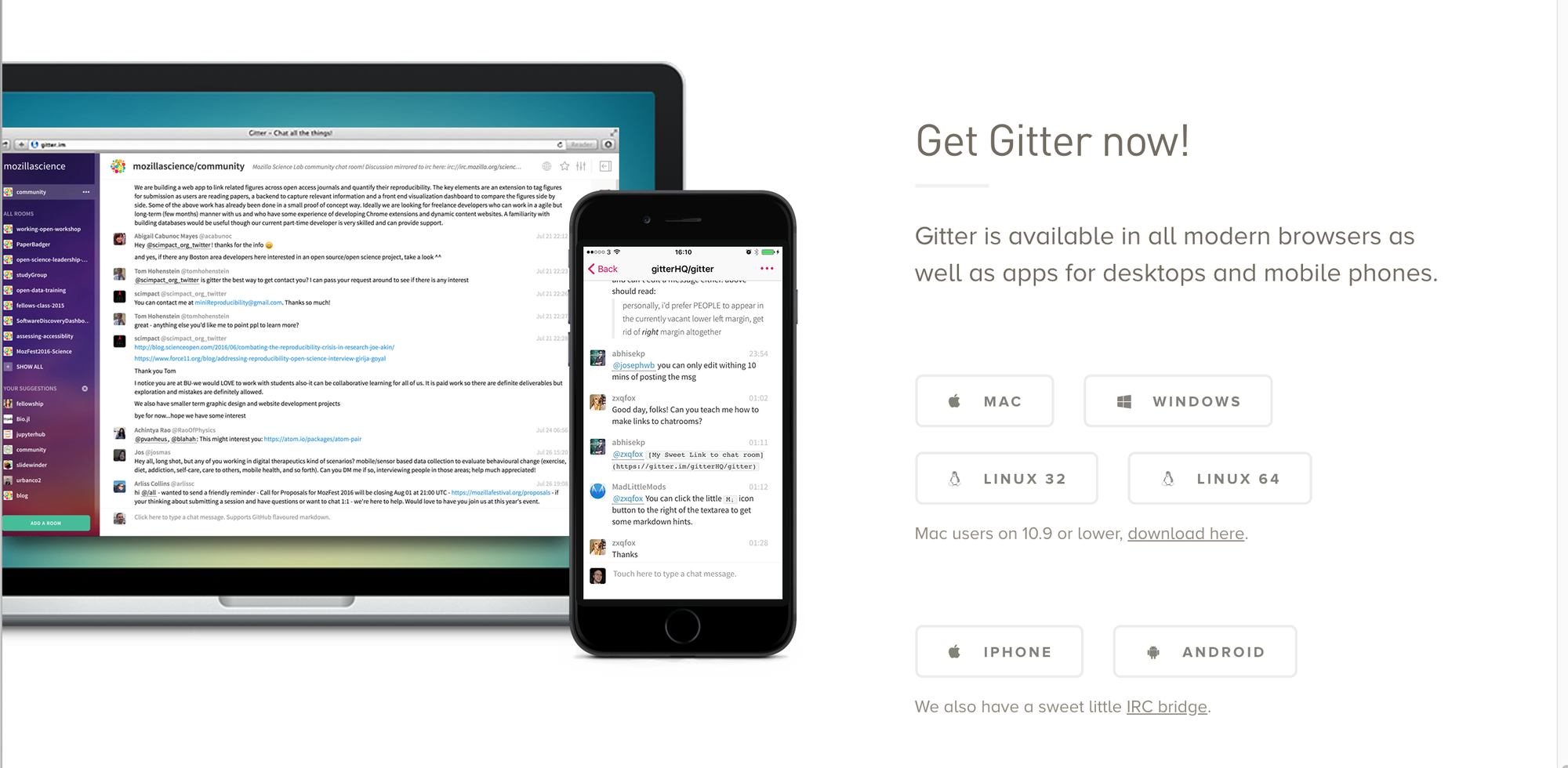
To get an idea of the importance of this platform, Gitter was bought by GitLab in 2017, when it already had more than 800 thousand users. Since then, it has been an open source project and without any limitation of use. This is because Gitter is no longer a company with a commercial purpose and has become GitLab's arm focused on developing communities that strengthen its position in the market (repository management for developers).
But this is not so relevant to us, other than for the fact that everything leads us to believe that Gitter is indeed a solid option and that it will not be discontinued. Speaking of options, some solutions are worth mentioning, if only to clarify how they differ from Gitter .
Among the alternatives is the Slack , a gigantic company, with daily activity of more than 12 million users. It is not, therefore, a niche option, but an alternative to communication for the world of work as a whole. In addition, its mission is internal communication between teams, not community management.
This field of generic solutions for the world of work seems to be quite congested, with multiple - and great - options, which would be a good subject for another post. Here I am restricting myself to comparing solutions to my concrete problem, which is the management of my communities. That is, the management of my classrooms.
Although it has had relative success in communicating with students via Slack and, more recently, via Discord , I ended up deciding to build a lighter and more open forum , which could be presented within the page of each course I teach. I was happy with the result and I hope it works better than my previous attempts, because I ended up realizing that I wasn't using the best tools for the mission.
The icing on the cake is that, precisely because it is a community in the world of technology, the development of Gitter is very agile and focused on integrations in different ways. In this case, I chose to use an integration called Sidecar , which allows you to display Gitter directly on the blog. The result is as follows:
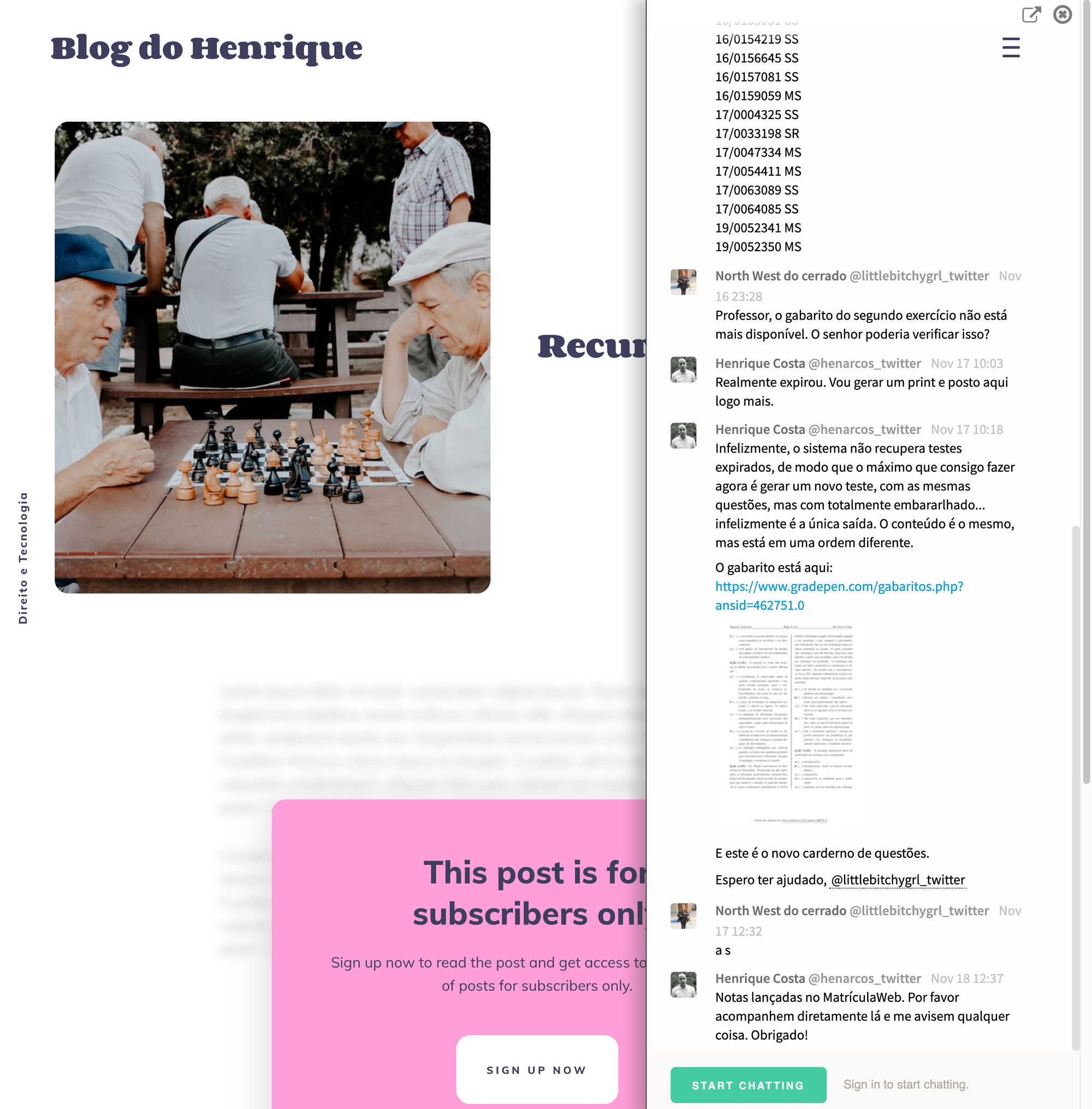
No more Whatsapp, no more Facebook Pages. 😅
In fact, I know that these solutions will continue to exist and that many students will be informed, second-hand, by posts propagated in those communities. The important thing for me is that I will be able to maintain organized and accessible communication, which I was having difficulty accomplishing through more complex tools.

